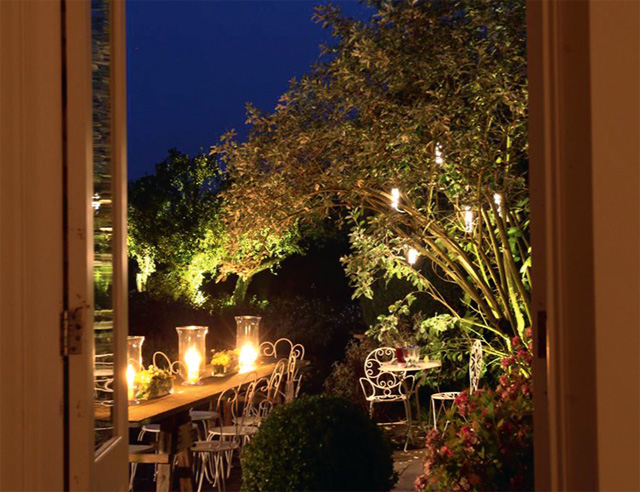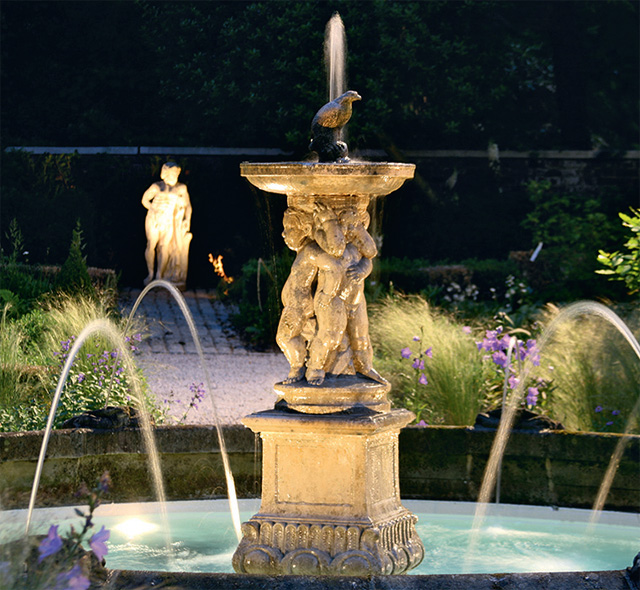Design your garden's lighting scheme
Once consigned to hotels and city gardens, a new range of subtle and energy-saving lighting devices are transforming country-house gardens, finds Arabella Youens


For purists, the only way to view a garden at night is when it’s bathed in moonlight. Surely no artificial light could possibly replace the romance of Vita Sackville-West’s White Garden at Sissinghurst, Kent, which she planted specifically to enjoy at nighttime from the vantage point of her tower? However, naysayers be on your guard: recent developments in lighting design have transformed the way that gardens can be gently and stylishly lit at night.
More and more country-house owners are taking a leaf out of the urban-garden book and creating evocative lighting schemes that set off the garden under the night sky. These are now commonplace in London’s most fashionable postcodes, but the trend started several years ago when Sally Storey, design director of John Cullen (020–7371 9000; www. johncullenlighting.co.uk), one of London’s leading lighting houses,started to light courtyards so that they became extensions to the house rather than being black spaces or hidden behind curtains.
However, until recently, efforts to emulate this approach have been somewhat limited by the technology available. ‘In the old days, outside lights for country houses were confined, in the main, to security lights, which shine directly into your eyes, and perhaps a hanging pendant above the front door,’ explains Mrs Storey.
‘Now that hot halogen lights have been replaced by low-watt LEDs, which don’t singe plants and require a lot less maintenance, you can create a warm, welcome look to the house by planting uplighters in the beds either side of the front door, which give a soft light filtered through the planting. A pair of decorative wall lights can still give the impression that they’re the main light source, but it’s just a trick of the eye.’
Beyond the front door, there are several further areas that can be considered for a discreet lighting scheme, including picking out a special tree and casting light over a pathway to the swimming pool or, of course, the parking area.
‘What you don’t want to do,’ advises Angus Gibson of house builders Symm (020–7411 9011; www.symm.co.uk), who is also the company’s technology expert, ‘is light your garden so that it ends up looking like an American fivestar hotel or a villa complex in the West Indies, where you half expect a golf buggy to appear around the corner. Some people will just ask their electrician to pepper walls and paths with lights and the result is simply awful.’
Lindsay Cuthill of Savills country-house department (020– 7016 3820; www.savills.co.uk) is in agreement. Savills are selling Mulberry House in Winchester, Hampshire. It boasts a spectacular lighting scheme in the garden, which has the cathedral’s silhouette as its backdrop. ‘When you have a garden in the country, you’ve got to take into account the environment—you don’t want to light up your garden like Piccadilly Circus if you’re in the middle of the countryside. Mulberry House works well because it’s within an urban landscape, but it wouldn’t necessarily be right in a village.’ Lighting, as far as Mr Gibson is concerned, is an art. ‘That’s why I think it’s fundamental to use a lighting designer—they will know the performance of every fitting, the correct positioning and the amount of light needed.’
Exquisite houses, the beauty of Nature, and how to get the most from your life, straight to your inbox.

Top tips for lighting your garden
Everyone agrees that less is more is the most important standard to go by. ‘Consider a couple of carefully placed focal points so that you have great views from the main rooms within a house,’ recommends Rebecca Weir of Light IQ (020–8749 1900; www.lightiq. com), another lighting designer. ‘And remember that darkness can be used to great effect— especially to conceal any less attractive areas,’ adds Mrs Storey.
Moonlighters -lighting trees
If you have a really tall tree, it might be worth considering some moonlighters—a treemounted fitting that gives a grey wash of light through branches below. ‘This is one of our favourite lighting techniques, simulating the effects of a full moon,’ explains Mrs Weir. ‘Place a light high within a mature tree, as high as possible. The light then shines through the branches to create wonderful dappled patterns of light on to a lawn or open space. This is often very dramatic when combined with up-lighting.’ Mrs Storey also recommends this approach for a turning circle or parking area. ‘We’ve installed one of our own moonlighters at Merton College, but it works just as well at a private house and it’s much more atmospheric than the flat glare of a security light.’
Outside dining
This is another area that can benefit from some clever lighting design, including hanging elements such as starlighters from the trees. The lights aren’t necessarily bright enough to eat by— some church candles in storm lanterns or, better yet, a flameless candle in the storm lantern (from Luminara; 01732 742104; www.luminara.co.uk) would be needed—but they help create atmosphere and are several steps more sophisticated (and dispel any whiff of Mexican restaurant decor) than hanging a string of fairy lights from a pergola.
‘From my kitchen window, I can see some starlighters hanging in the tree by the table. Beyond that, I’ve lit the odd apple tree. It’s rather simple and rambling, but the light invites you out,’ explains Mrs Storey. ‘For a really pretty result, grouped starlighters suspended at random in threes or fives create a twinkling effect.’

Be eco-friendly
One stumbling block to garden lighting has been the expense, but with the current range of LED lights, the energy used is a fraction of what it would have been even just a few years ago and, today, it’s possible to transform even a relatively large garden with as little as 200w. ‘That and the fact that they don’t get hot makes them much more eco- and garden-friendly.
But, although they don’t burn out like halogen lights, they do still need a bit of care and attention: rain and wind can clog up the glass covers and you’ll need to cut things back from time to time, but it’s much easier than it used to be,’ says Mrs Storey.
How to choose an outdoor lantern
‘The style and finish of a light should obviously reflect its setting. Verdigris, a hand finish, often works well in gardens as it emulates the muted green tones of organically aged bronze, copper and brass. It’s important to keep the proportions of the surrounding architecture in mind when choosing outside lights. Lanterns or wall lights that are too small tend to look rather mean, so, if in doubt, go for a larger size. Downlighting and limiting the beam angle from a light are beneficial for wildlife and reducing light pollution of the night sky— choosing a lantern with a roof can help achieve this.’
Charles Edwards (020–7736 8490; www.charlesedwards.com)
* This article was first published in Country Life magazine on July 23 2014
* Follow Country Life on Twitter
